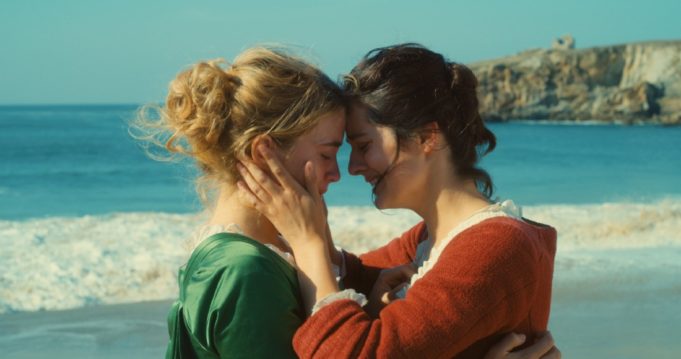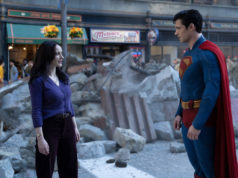Today’s film-school term is “male gaze.” Developed in the 1970s by British film theorist Laura Mulvey, this idea holds that movies are made from a male point of view and objectify women for the pleasure of men in the audience. (The film critic-turned-director Jean-Luc Godard put it more succinctly: “The history of film is boys photographing girls.”) You can likely think of more than one exception to this rule, but over the broad sweep of film history, it holds up.
The reason I start with this is because I’ve yet to see a film that shows us what a female gaze looks like more than Portrait of a Lady on Fire, which was supposed to play locally before the coronavirus epidemic intervened. As of last Friday, it is on Hulu. I first saw this French lesbian romance on my TV for awards consideration last year and found it good enough to place on my Top 10 list on that basis. If you ever have a chance to see this surpassingly beautiful film on the big screen, don’t miss it.
Our story begins on an island off the coast of Brittany in the mid-18th century, where Marianne (Noémie Merlant) is brought to a large estate. She is about as free as a woman can be in this time and place. The daughter of a famous painter, she has trained in her father’s trade, produced enough work to earn her own reputation, and is set to take over his business. For the moment, she has been commissioned by an Italian aristocrat (Valeria Golino) to paint a portrait of her daughter Héloïse (Adèle Haenel), who’s engaged to a Milanese nobleman. He wants a picture of his future wife to determine whether she’s attractive enough to marry, and the sullen Héloïse has already driven off a previous artist — in her defense, she’s grieving her older sister, who either fell or jumped off a sea cliff rather than marry that same man. Marianne is given a week and instructed to paint Héloïse in secret.
This is by Céline Sciamma, whose four previous films have all been contemporary low-budget stories, mostly about lesbians. (Ironically, I thought her best movie prior to this was her non-lesbian coming-of-age story Girlhood.) On the small screen, the precision and clarity of this story comes through. Sciamma’s austerity is dictated by the rhythm of ocean waves smashing against the beach and the setting of a giant, sparsely populated house, as Héloïse’s mother departs for Paris and leaves the two women with only one servant girl (Luàna Bajrami) for company. However, the big screen reveals how the gifted cinematographer Claire Mathon contrasts the actress’ flesh against the vivid colors of their dresses. She and Sciamma conjure a remarkable nighttime scene in which the women mingle with the local peasants and hear them sing a futuristic-sounding harmonized song around a campfire, where Héloïse lights her dress’ hem on fire. The filmmakers also give Héloïse a masterfully stage-managed first entrance, as Marianne can only see the back of her head as she walks and then breaks into an alarming run toward the same cliffs where her sister died. French speakers will appreciate the play on the words mourir (“to die”) and courir (“to run”) that follows.
The film, which has a grand total of two lines of dialogue spoken by men, is all about the way women see and not just through Marianne having to look at Héloïse in order to capture her likeness. The movie tracks the creation of the painting itself, as Marianne mixes shades of green for the folds of the dress that Héloïse is supposed to be wearing. That servant girl is making her own art, studying a blossoming orchid to depict it in her embroidery. A literary reading prompts the three women to creatively deconstruct the story of Orpheus and Eurydice, which is all about the act of seeing. The way the camera takes in Héloïse’s body in various states of dress and undress does more than reflect Marianne’s growing attraction to her. It also shows how a lesbian who desires a woman looks at her differently than a straight man would. There’s also a personal element to this — Sciamma and Haenel were in a long-term romantic relationship that broke up just before the film started shooting. The tall, regal-looking Haenel (who, incidentally, is at the center of a massive #MeToo scandal in France) is not only an intriguing object of desire but also an apt foil to Merlant, who excels at the whole “stoic façade roiled by deep emotions” thing.
Portrait of a Lady on Fire plays like a lesbian version of Call Me by Your Name, though its visuals are sharp where Luca Guadagnino’s were gauzy. The romance has a hard deadline when Héloïse’s mother returns, and it makes the women determined to seize as much happiness as they can during that short time. The end of their love is crushing and also leads to a deeply moving ending that’s set years later, when Marianne sees Héloïse from afar at a concert hall, reduced to tears by a performance of “L’Estate” from Vivaldi’s The Four Seasons, a piece of music from their time together. It is the breathless final stroke from a film full of sights that will change its characters forever.
Starring Noémie Merlant and Adèle Haenel. Written and directed by Céline Sciamma. Rated R.












